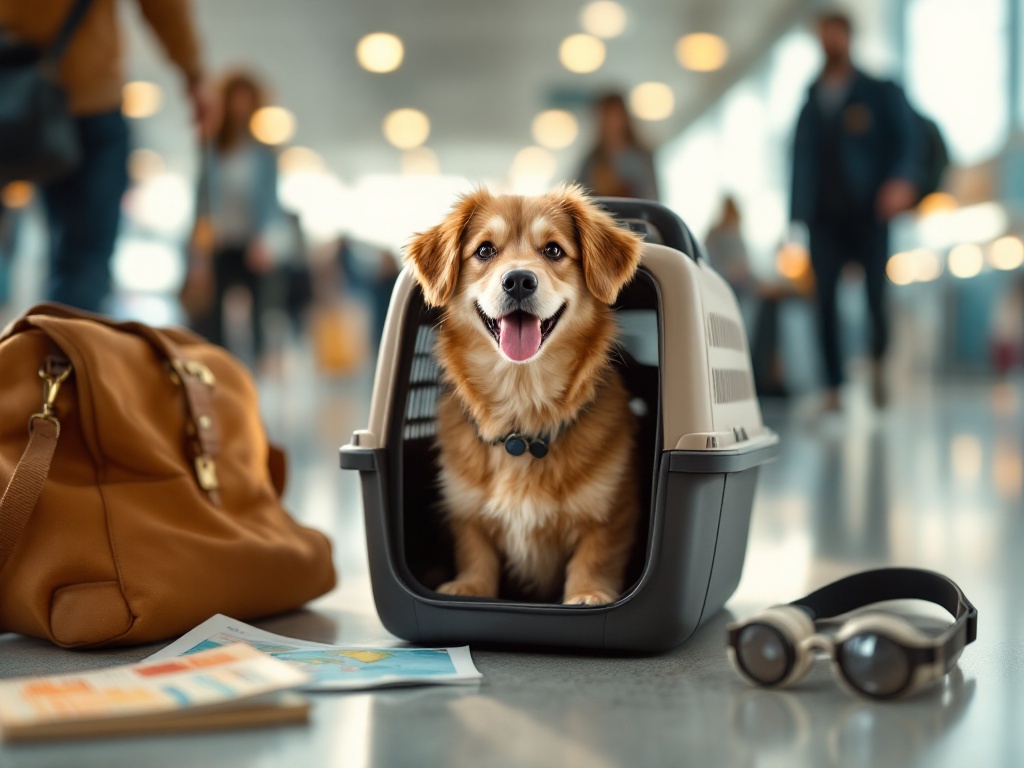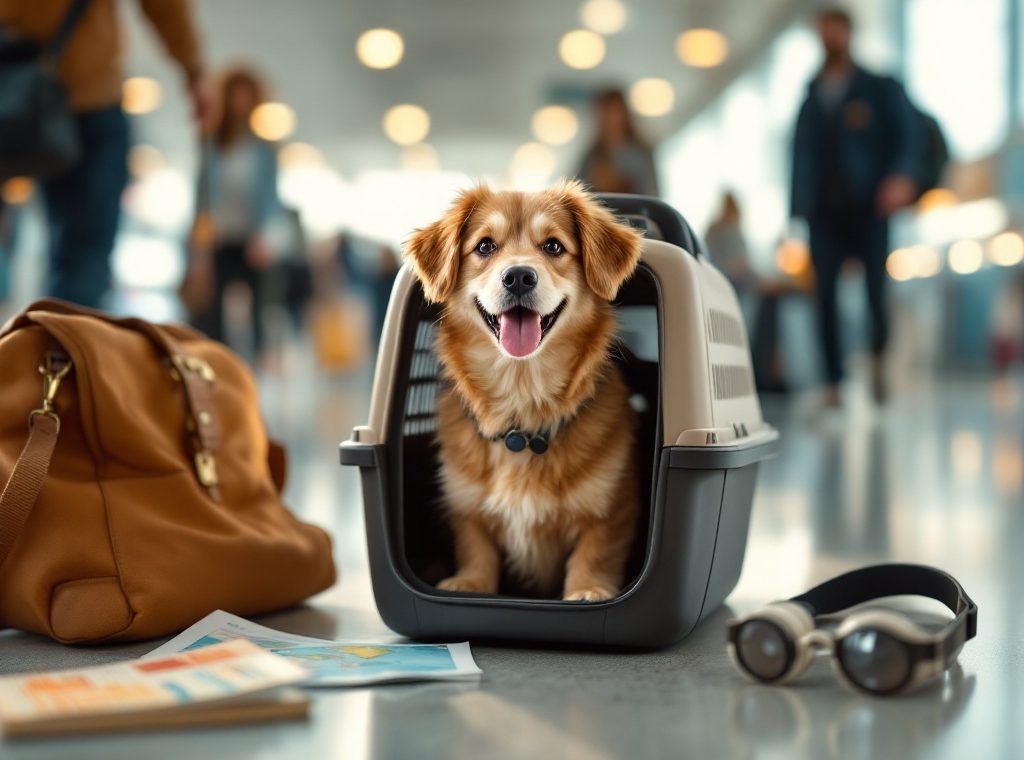Traveling with Pets: Rules and Guidelines
Traveling with your beloved pet? Ensure a smooth and stress-free journey by understanding crucial travel requirements. From airline-specific carrier regulations and pet age limits to international documentation and quarantine guidelines, proper planning is key. Discover essential tips for a comfortable trip, including carrier selection, health certificates, and managing travel anxiety. Learn how to navigate pet travel regulations and make your next adventure with your furry friend a success. Read on to prepare for a paw-some journey!
Important information

- Research pet travel rules for your transport and destination. Check breed restrictions, needed health documents, and age limits.
- Use a suitable carrier that meets airline or other transport rules (size, ventilation). Get your pet used to it before traveling.
- Ensure proper pet identification (microchip, tags with contact info). A vet health certificate with up-to-date rabies vaccination is key.
- For international travel, check the destination country’s rules: needed tests, quarantine, and other paperwork (pet passport, import permits).
- Plan for a comfortable journey: Pack food, water, medications, leash, waste bags, and comfort items. Schedule breaks for long trips.
Understanding Travel Requirements for Pets
Traveling with your pet can be a rewarding experience, but thorough planning is essential. Before embarking on your journey, whether by plane, car, train, or boat, research the specific pet travel regulations for your chosen mode of transport and destination. Check for any breed restrictions and required health documents at your destination. Ensure your pet has proper identification, such as a microchip, and that all vaccinations are up-to-date.A suitable travel carrier is crucial for your pet’s comfort and safety. The carrier should comply with airline or other transport guidelines, particularly regarding size and ventilation. Be mindful of additional restrictions for short-nosed breeds, such as pugs or bulldogs, who may experience breathing difficulties during air travel. For international travel, confirm the destination country’s pet import regulations, including potential quarantine periods and specific health tests. By planning ahead, you can ensure a smooth and enjoyable trip with your beloved companion.
Pet Travel Requirements for Different Modes of Transport
Traveling with your cat or dog is easy. Small cats and dogs are welcome to travel with you in the cabin in an approved carrier. We accept both hard and soft-sided carriers, providing a comfortable and safe journey for your pet.
Age and Health Requirements for Pet Travel
Traveling with your pet? Be aware of age restrictions. For travel within the U.S., your pet must be at least eight weeks old. If you’re traveling internationally to the U.S., dogs must be at least six months old. For travel to the European Union, your pet must be at least fifteen weeks old. Remember that destinations may also have specific health requirements, such as vaccinations and health certificates.
Documentation and Health Certificates for Pet Travel
Traveling with your pet requires specific documents. Ensure your pet’s health and vaccinations are up-to-date with a vet’s health certificate, paying close attention to rabies vaccination. Confirm specific requirements with your destination and transport provider, as they can vary significantly.Pet identification is crucial. Use tags with your contact and medical information. For international travel, a pet passport, import permits, and additional health tests might be necessary. Contact the destination country’s embassy or consulate for detailed information on required tests and paperwork.
Obtain a vet’s health certificate confirming your pet’s health and vaccinations, especially for rabies.
Ensure your pet’s identification is clear, using tags with your contact and medical information.
For international travel, secure a pet passport and any necessary import permits and health tests.
Prepare these documents well in advance, as a health certificate is typically valid for a short time, often just 10 days. Planning ahead prevents travel complications.
Planning and Preparing for Pet Travel
Traveling with your pet requires planning. Acclimate your pet to their carrier with short trips to reduce travel stress. Ensure they have proper ID, including a collar with tags and a microchip. Pack essentials like food, water, and any necessary medications. A leash, waste bags, and a favorite toy or blanket can also make the journey more comfortable.
Schedule a vet visit to ensure your pet is healthy and up-to-date on vaccinations.
If flying, research airline pet policies, as they can differ.
For longer journeys, plan breaks for exercise and bathroom stops.
Stay relaxed. Your pet will mirror your demeanor, so a calm owner often translates to a calmer pet.
Creating a Pet Travel Checklist
Traveling with your pet requires some preparation. Ensure your pet’s ID tag displays current contact information. Consider microchipping your pet for permanent identification in case they get lost. Remember essential documents like vaccination records and a health certificate. Pack necessities such as food, water, bowls, a leash, and waste bags. Don’t forget any necessary medications. For added comfort, bring a favorite toy or blanket. Acclimate your pet to their carrier beforehand to minimize travel stress.
Update Pet Identification. Ensure your pet’s ID tag displays your current contact information.
Consider Microchipping. A microchip provides permanent identification if your pet gets lost.
Gather Essential Documents. Remember vaccination records and a health certificate.
Pack Necessities. Pack food, water, bowls, a leash, and waste bags.
Pack Medications. Don’t forget any necessary medications.
Bring Comfort Items. Bring a favorite toy or blanket for added comfort.
Acclimate to Carrier. Acclimate your pet to their carrier beforehand to minimize travel stress.
Emergency Planning and Contacts for Traveling with Pets
Traveling with your pet requires preparation. Before you go, create a contact list that includes your regular veterinarian, emergency vets near your destination, a 24/7 animal poison control hotline, and your pet’s insurance information. Pack any relevant medical records. Remember that travel isn’t suitable for all pets due to factors like age, illness, injury, or temperament.
Tips for Stress-Free Travel with Pets
Always keep your pets on a leash when visiting parks, campgrounds, or marinas.
Acclimate your pet to their carrier with short trips before any long journeys to minimize travel stress.
Ensure your furry friend has proper identification, including a collar with tags and a microchip.
Remember to pack essentials like food, water, and any necessary medications.
For longer trips, schedule regular stops for exercise and bathroom breaks.
If your pet suffers from travel anxiety, consult your veterinarian about potential medications.
A pre-trip checkup and updated vaccinations are also crucial.
Consider your pet’s temperament and the trip’s length when planning.
Research pet-friendly accommodations and any required health certificates.
Rules and Guidelines for In-Cabin Pet Travel
Traveling with your pet? Airline pet policies and carrier requirements vary, so careful planning is essential. Most airlines allow small pets, such as cats, dogs, and sometimes birds, in the cabin. Choosing the right carrier is crucial for a smooth journey.
Key Carrier Requirements
- Leak-proof design, preventing accidents during the flight.
- Adequate ventilation, ensuring your pet has fresh air throughout the journey.
- Sufficient space, allowing your pet to stand, turn around, and lie down comfortably.
Airline-Specific Rules
Always check your airline’s specific pet travel policies. They often have precise restrictions on carrier size and materials. Confirming these details in advance will prevent any last-minute surprises at the airport.
Carrier size is particularly important, as it typically needs to fit under the seat in front of you. A common maximum size is around 17″ long, 11″ wide, and 9.5″ high. However, these dimensions can vary between airlines. Always confirm the allowed carrier size with your specific airline before your trip to ensure a comfortable and stress-free experience for both you and your pet.
Allowed Pets and Carrier Requirements
You can bring your cat or dog in the cabin, provided they travel in a carrier, which can be either hard-sided or soft-sided.
Carrier Size and Placement Regulations
For your pet’s comfort and safety during air travel, choose a carrier that fits under the seat and meets your airline’s specific size and ventilation guidelines. Inside, your pet should have enough space to stand, turn around, and lie down comfortably.
Airline Policies and Regulations for Pet Travel
Planning your pet’s flight? Here’s a helpful guide. Airlines have specific rules for pet travel, including carrier size, ventilation, fees, and cabin versus cargo travel. Some airlines limit the number of pets allowed in the cabin, so book early and confirm your pet’s reservation. Also, check for breed restrictions.Temperature is crucial, especially for pets in cargo. Airlines often have temperature restrictions for your pet’s safety and may refuse transport in extreme heat or cold. Check specific temperature limits and embargo periods before flying.Many airports have pet relief areas where your pet can stretch and take breaks. Find these areas on the airport’s website or ask airport staff.
Booking Pet Travel on Airlines
Planning your next flight with your pet? Here’s what you need to do:
Contact the airline early. Pet spots are limited, so booking in advance is essential.
Confirm carrier requirements. Airlines have specific regulations regarding pet carrier size and type.
Gather necessary documents. Ensure you have all required health certificates and travel documents for your pet.
Inquire about pet fees. Be sure to ask about any associated fees for traveling with your pet.
Temperature and Cargo Travel Restrictions
Airlines often restrict pet cargo travel during extreme temperatures to ensure their safety. These crucial embargo periods, especially common in very hot or cold months, protect animals from dangers like heatstroke and hypothermia.
Pet Relief Areas at Airports
Traveling with your pet can be stressful, but most airports now offer pet relief areas to make the journey more comfortable for both of you. Check with your airline or the airport directly to find the specific locations and amenities available. Knowing where these spots are located can significantly improve your travel experience.
International Travel with Pets: Regulations and Considerations
Traveling internationally with your pet requires careful planning, especially regarding country-specific regulations. These regulations often include age restrictions, breed limitations, and identification requirements. Some countries may impose minimum age limits for entering pets, while others might restrict or ban certain breeds. Quarantine periods could also apply depending on the destination. Thoroughly research your destination’s specific rules and regulations well in advance. Microchipping your pet is strongly recommended, and ensure their collar displays current contact information. This is crucial for a safe return should your pet get lost. A microchip, combined with clear ID tags, offers an additional layer of security. By taking these preparatory steps, you can ensure a smooth and stress-free international journey with your pet.
Pet Age Requirements for International Travel
To enter the European Union, your pet needs to be at least 15 weeks old.
Countries with Pet Travel Restrictions
Traveling with pets can be complicated due to different rules in each country. Some countries, like Australia, New Zealand, and the UK, require mandatory quarantine, which can be lengthy. Others, like Japan and Singapore, restrict specific breeds. Some island nations, such as Fiji and French Polynesia, don’t allow pets at all. It’s important to research your destination’s specific pet regulations to avoid problems.
Microchip and Identification Tags for International Travel
Microchips significantly increase the likelihood of recovering a lost pet, paving the way for a joyous reunion. Many countries require them for pet entry, further emphasizing their importance. Identification tags with up-to-date contact information are also essential, especially for international travel.
Pet Safety and Comfort During Travel
Traveling with your pet can be a breeze with a little planning. A comfortable carrier is essential, offering good ventilation and enough room for your pet to stand, turn around, and lie down. Look for a leak-proof bottom and secure latches. Introducing the carrier at home can help reduce travel stress.For longer trips, consider these tips:
- plan regular stops for potty breaks and exercise,
- always provide fresh water,
- bring familiar toys and blankets for comfort,
- maintain your pet’s regular feeding schedule to minimize stress, and
- consult your vet about travel anxiety and potential medications.
Ensure your pet has clear identification, including a collar with tags and a microchip, to guarantee a safe return if they get lost.
Choosing the Right Carrier for Safe Pet Travel
Traveling with your pet requires a safe and comfortable carrier. Whether you choose a hard-sided or soft-sided carrier, ensure it’s spacious enough for your pet to stand, turn around, and lie down comfortably. Prioritize carriers with ample ventilation for proper airflow. Durable materials and secure latches are essential for a safe journey. Easy cleaning is a bonus for maintaining hygiene. Check with your airline about carrier size and design regulations before flying, as these can vary. To reduce travel anxiety, acclimate your pet to the carrier well in advance of your trip.
Choose a suitable carrier: Select a hard-sided or soft-sided carrier that allows your pet to stand, turn around, and lie down comfortably.
Ensure proper ventilation: Prioritize carriers with plenty of airflow to keep your pet comfortable.
Check for durability and security: Opt for carriers made of durable materials with secure latches for a safe journey.
Consider easy cleaning: Choose a carrier that is easy to clean for hygiene purposes.
Verify airline regulations: Check with your airline about carrier size and design regulations before your trip.
Acclimate your pet: Get your pet used to the carrier in advance to reduce travel anxiety.
Ensuring Pet Comfort and Health on Long Journeys
Traveling with your pet requires careful planning. Before the trip, consider your pet’s age, health, and temperament, and consult your veterinarian. Acclimate your pet to their carrier by taking short trips beforehand. Pack essentials: food, water, medications, leash, waste bags, and a favorite toy or blanket. During the journey, frequent breaks are crucial for your pet to stretch, relieve themselves, and hydrate. A well-ventilated and comfortable carrier is essential for a smooth trip. Ensure your pet’s identification tags are current.
Consult your veterinarian to discuss your pet’s travel readiness, considering their age, health, and temperament.
Acclimate your pet to their carrier with short trips before the long journey.
Pack essential items: food, water, medications, a leash, waste bags, and a favorite toy or blanket.
Take frequent breaks during the trip to allow your pet to stretch, relieve themselves, and hydrate.
Use a well-ventilated and comfortable carrier.
Ensure your pet’s identification tags are up-to-date.












